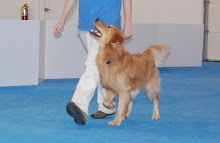Today I noted a pattern that has developed with Griffin. We do heeling at the park. I reinforce a few times for great parts. The first one is absolutely beautiful. On the second set, I reinforce at different points, but the same amount of reinforcement. And he's much worse. Wanders more. Or less attentive. Or sniffing.
A few of my options:
- Only ever do one set of heeling.
- Do more, super short sets to see what happens.
- Do two sets, but use a much higher rate of reinforcement on the second set.
- Be in a new place for each set
A pattern we talked about last week.... a dog in class would jump every time the leash was put on. They would freeze and wait for him to be still. Then clip it on and go. But this had been going on for months and months with no change in the behavior. The dog had learned.... leash = jump on humans = humans ask for a sit = Dog sits = leash on = go for a walk. A nice behavior chain, well practiced and maintained for months on end.
How did we resolve and break that pattern?
1) Change the leash cue. Practice leash out, asking for a sit, feed a treat and repeating many times in a row. The many repetitions would help the dog learn faster. Practicing in a different location (not at the door)! will help the dog stop the jumping.
2) Practice sitting at the door. Approach the door, cue a sit, feed a treat. Walk away and return and repeat.The door will be a cue to sit.
3) If the dog does jump up...we will not stand still and then continue putting on the leash. We can go about our day, go check the oven, etc. Standing still and continuing had -not- changed the behavior.
4) When we do need to hurry out, scatter treats on the floor and while the dog is eating, clip on the leash and go out. This will break the pattern of jumping and not have the anxiety/frustration that standing still could have. This is a preventative measure until the training is in place.
Walking is one of my favorite things to teach. That said, I don't work so hard with my own dogs on walking. Griffin gets absolutely frenzied when we're going to the pond. He is completely focused on pulling ahead and getting there as fast as possible. So that I don't reinforce the hard pulling, I stop and wait for him to resume some level of manners before we continue. We go forward a step and he springs forward. Every week, students tell me about this happening on their walks. It's not a good pattern. Pull on leash. Human stops. Look at human. Human goes forward a step. Dog pulls as far as possible. Repeat and repeat.
How do we break this pattern? Use more reinforcement for the good behavior. Sure...going forward definitely is reinforcement, but we can see it's not the most desirable in this situation. Dogs can go months without learning to walk well...and Griffin's behavior sure hasn't changed. We add in additional reinforcement, typically food, at every single step. We start close to the house, leaving a few steps, then back to the house, then leaving a bit further, then back up to the house.... back and forth, gradually expanding the area where the dog can walk reasonably. No more "walks just for exercise" until the dog can walk well... back and forth, back and forth. Otherwise the training is compromised by letting the dog pull.
Griffin is getting that too...we go out about ten times a day for 90-120 seconds of walking training. Gradually further from the house, gradually closer to the pond. When I do need to take him there for exercise...we either just don't (and go somewhere else, do something else) or I use a treat magnet/treat transport from well in our safety zone to the pond gate.
We're constantly watching for patterns (good or bad!) in training so that we can adjust or utilize the pattern appropriately. Most end up not being desirable.





No comments:
Post a Comment